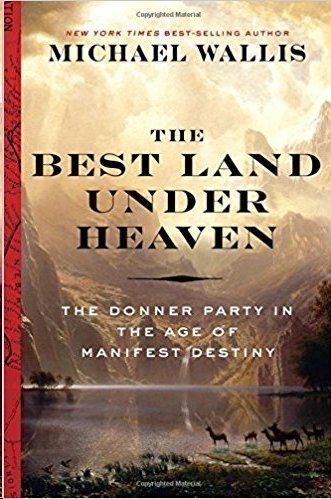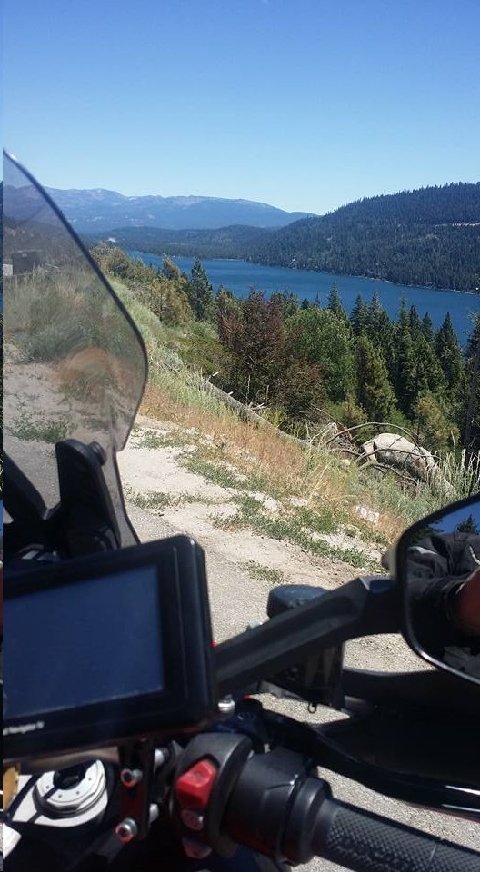"The Best Land Under Heaven" by Michael Wallis

Above: "The Best Land Under Heaven - The Donner Party in the Age of Manifest Destiny." Michael Wallis. 358 Pages.
"We have left everything, but I don't care for that. We ave got through with our lives. Don't let this letter dishearten anybody. Remember, never take no cutoffs and hurry along as fast as you can."
Virginia Reed (Letter to cousin from Donner Party survivor).
I completed reading this book today.

Image 1. Big Mountain Summit, Morgan County, UT.
On Saturday, 15 July 2017, knowing I was on the point of finishing this book, I rode the Duc to some nearby way points of the Donner Party. I wanted to channel, first hand, the intense and riveting narrative I had been reading over the last week.
Having left Springfield, MO a bit late (15 April 1846) and wanting to make up some time, the Donner Party decided to take a "short cut" recommended by California promoter, Lanford B. Hastings.
The usual way to California would be to follow, north of the Great Salt Lake, the Oregon Trail to the northwest from Big Sandy, Wyoming. At Fort Hall, Idaho veer left, leaving the Oregon Trail, then head south to join the Humboldt River in Nevada; then, proceed onward across the Sierra to Sutter's Fort, California, via Truckee (now Donner) Pass.
Hastings promoted a "shortcut" which directed travelers southwest from the Big Sandy River, to Fort Bridger, and then, onward across the Wasatch Mountains, the Great Salt Lake Desert, south of the Great Salt Lake, to connect with the Humboldt River near present day Elko, Nevada.
Among other difficulties, the "shortcut" resulted in a ten day delay for the already late arriving Donner Party, because of having to blaze in the Wasatch Mountains, a new trail from three miles north of Big Mountain Summit, to the Valley of the Great Salt Lake, twenty miles further on.
It is sobering to stand atop Big Mountain, realizing that only 171 years ago, on 16 August 1846, members of the ill fated Donner Party stood at this very point and contemplated the hostile Great Salt Lake Desert and beyond.
It is even more sobering to imagine what the landscape looked like in 1846 and the fortitude of the travelers who would have to tame it...no bulldozers back then!
The Wasatch trail blazing delay would be only the beginning of the Donner Party's ordeal to be experienced over the course of the next six months.

Above: 2nd Image. Donner Lake from the Duc. 10 August 2016 (a year ago).
On a Duc ride last year, before I started reading the subject book, I stopped to capture an image of Donner Lake, Truckee County, California, where the Donner Party was trapped by Sierra snows for four months.
The Donner Party's Sierra ordeal is well rehearsed in American history and lore. Some members of the Donner party had to resort to cannibalism of dead compatriots to stay alive during one of the worst Sierra winters in memory at that time.
Not all Donner Party members resorted to cannibalism.
Conventional wisdom says that no person was killed to provide sustenance. Only travelers who had already died were consumed for food and no one consumed the flesh of a relative. As this book reveals, that is not wholly true. Two Indian guides who had been seconded to the first relief effort, were shot and consumed for food, by two errant members of the first relief effort when relief caches of food, stored en route, had been ruined by animals.
Observations:
I've read several accounts of the Donner Party over the years.
Motorcycling, I've ridden many times most of the Donner route, from the Big Sandy River, in Wyoming to the Sierra western slope foothills in California.
Notwithstanding a good degree of familiarity with the Donner story, there were some new insights I gleaned from reading this book.
MORMON CONNECTION
I hadn't known (remembered?) that Lilburn Boggs, former governor of Missouri, was part of the Donner wagon train starting out from Springfield, IL.
As governor of Missouri, on 27 October 1838, Boggs had issued a widely known and controversial "extermination order" to drive the Mormons out of the state of Missouri.
For some time prior to the wagon train's arrival at the Big Sandy River, Boggs had actually served in the elected position as wagon train leader. Then, the train was known as the Boggs Wagon Train.
The author notes that even 18 years after his famous extermination order, Boggs was worried about the dangers to his person that being near Mormons might entail. Where the Donners chose to take the Hastings shortcut, Boggs said he would take the northern route, and then, continue on to Oregon. Boggs, according to the author, wanted to avoid California because he felt there would be too many Mormons there.
In fact, at Fort Hall, Idaho, at the junction of the California and Oregon routes, Boggs changed his mind again and decided to go to California. He was at Sutter's Fort when first word came about the Donner Party trapped in twenty five foot deep snows on the western slope of the Sierras.
DONNER/FANCHER
My mind on remote control while riding the Duc last year, near Donner Lake, I wrote an irreverent poem/ditty conflating the Boggs/Mormon connection of Donner Party wagon train and the Arkansas/Missouri Mormon linkage with the Fancher Train, most of whose members (but for children under six) were killed by Mormon settlers in Southern Utah in 1856 - The Mountain Meadows Massacre. Intertwined with the fates of both wagon trains was a connection to early conflict between Mormons and non Mormons in 1830s frontier Missouri.
Donner/Fancher
Donner, Fancher. Wagon train.
Each receives its share of pain.
Donners delectable every bite.
Fanchers snuffed out for a slight.
Female fat saves Donner belle.
Little Fanchers. They won't tell.
LANFORD W. HASTINGS
History has cast Lanford W. Hastings as a fraudster. More likely, he was a well meaning promoter caught up in the hype of James K. Polk's call of Manifest Destiny.
Hastings hadn't traveled the Hastings Cutoff himself before he recommended it, but, he was taking the cutoff, a week ahead of the Donners, with another group.
Hastings left written notes along the cut-off trail giving the Donners, who were a week behind his party, tips about the road ahead. The Hastings group had fewer wagons and more pack animals. Rather than taking the Big Mountain route trail blazed by the Donners, Hastings' group entered the Great Salt Lake Valley via Weber Canyon.
Weber Canyon was hard enough and Hastings, realizing that the Donnors had many large wagons, suggested by posted message that the Donners avoid the Weber route and go the Big Mountain way. The Donners lost eleven days in trailblazing via Big Mountain, where Hastings lost only a day or two in Weber Canyon.
Hasting's booklet, recommending the Hastings Cutoff south of the Great Salt Lake, contained some good advice... such as admonishing travelers not to leave late... advice which the Donners did not follow.
The Hastings Cutoff was used - at least as far as the Great Salt Lake Valley - by the Mormon Pioneers one year later. Once the Big Mountain trail was blazed by the Donners, the Mormon pioneers had an easier crossing of the Wasatch than they would have had they have had to blaze the trail themselves.
Subsequent California travelers used the Hastings Cutoff successfully, though the principal California route, before the railroad came in 1868, continued to be through Fort Hall in Idaho, north of the Great Salt Lake.
The Pony Express, for its two years of existence, followed the Hastings Cutoff.
So... Hastings wasn't totally out to lunch.
Circumstances created a perfect storm.
The Donner Party was the last 1846 party to leave Independence, Missouri for the California crossing... they left a bit late. Un-forecasted difficulties in crossing the Wasatch and the Great Salt Lake Desert created further delay. Early, severe, October snows in the Sierra stymied their goal to reach Sutter's Fort. Notwithstanding all this, saving only two or three days would have made all the difference in the Donner Party reaching California safely.
JAMES REED AND IRONY
The Donner Party is often called the Donner/Reed party. Patriarch James Reed was a capable, prosperous Illinois landowner who sought a better life for his family. California was where his future would lie, he believed.
The Reeds were friends with Abraham Lincoln, then a Springfield, IL lawyer. Lincoln provided a reference for Reed to use when he would arrive in California.
One of the Reed daughters, in memoirs/letters written in the 1870's claimed that her father had convinced Abraham and Mary Todd Lincoln to join them on the trek to California, before the Lincolns changed their minds.
Author Wallis says that Reed was the most capable member of the Donner group. But, says Wallis, Reed was brash and arrogant. He rubbed his fellow travelers the wrong way.
Reed was the primary supporter of taking the Hastings Cutoff. After the ordeal of the eleven day trail blazing delay in the Wasatch, and the disastrous crossing of the Great Salt Lake desert, where cattle and stores were lost, the train members blamed Reed for the trains' suffering, and spent much time grumbling against him.
Near present day Reno, Nevada, at the base of the Sierra foothills, Reed got into an argument with a hired hand, a wagon master, of another family in the 87 member 20 wagon group. Reed pulled a knife in self defense and killed the wagon master.
The camp was divided on what should be done with Reed. Some wanted to hang him. The camp settled on banishing him, allowing him no supplies.
After Reed left the camp, his wife, under cover of darkness, sent a hired hand with some supplies and a fire arm, to join her husband. Together, Reed and his hired hand crossed the Sierras and reached Sutter's fort before the snows came.
On arrival at Sutter's fort, the resourceful Reed started making contacts and buying land. When two months later he found that there were survivors of his party (including, hopefully his family members) holed up in the Sierra snows, he became the leader in mounting the relief efforts which eventually extracted his family members and others from their camps in the Sierra.
All of Reed's family survived, wife and five daughters. Reed became a notable Californian and a wealthy man.
HOLED UP AND RELIEF
Two thirds of the book is devoted to the ordeals experienced by Donner Party members in the Sierra winter. Eleven major snow storms, some lasting up to ten days, swept over the range in the winter of 1846/47.
New materials, diaries, and perspective from a distance enable Wallis to provide the most comprehensive narrative of the Donner Party to date.
MORAL
"We have left everything, but I don't care for that. We have got through with our lives. Don't let this letter dishearten anybody. Remember, never take no cutoffs and hurry along as fast as you can."
-Virginia Reed (from letter written as thirteen year old to her cousin, just after rescue from her ordeal at Truckee Lake).